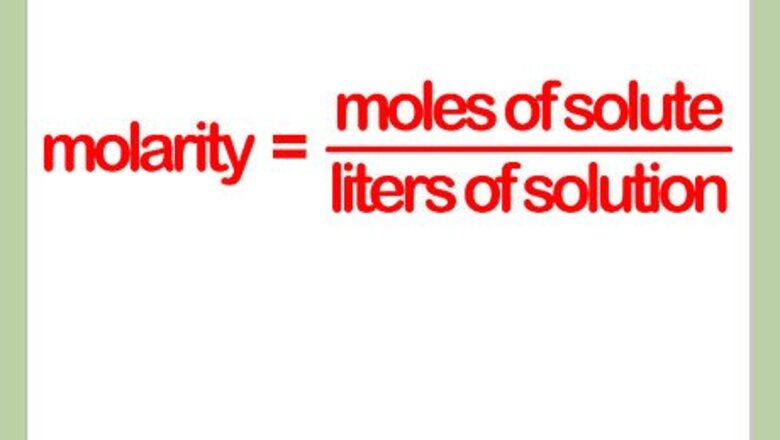
views
X
Research source
To calculate molarity, you can start with moles and volume, mass and volume, or moles and milliliters. Plugging these variables into the basic formula for calculating molarity will give you the correct answer.
Calculating Molarity with Moles and Volume

Know the basic formula for calculating molarity. Molarity is equal to the number of moles of a solute divided by the volume of the solution in liters. As such, it is written as: molarity = moles of solute / liters of solution. Example problem: What is the molarity of a solution containing 0.75 mol NaCl in 4.2 liters?

Examine the problem. Finding molarity demands that you have the number of moles and the number of liters. If the problem provides each of these figures, no preliminary calculations are needed. Example problem: Moles = 0.75 mol NaCl Volume = 4.2 L
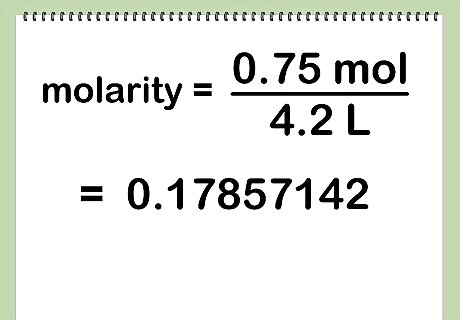
Divide the number of moles by the number of liters. The resulting quotient will give you the number of moles per liter of solution, otherwise known as molarity. Example problem: molarity = moles of solute / liters of solution = 0.75 mol / 4.2 L = 0.17857142

Write your answer. Round off the number of digits after the decimal point to two or three, depending on your instructor's preference. When you write out the answer, abbreviate "molarity" with "M" and state the chemical abbreviation of the solute involved. Example problem: 0.179 M NaCl
Calculating Molarity with Mass and Volume

Know the basic formula for calculating molarity. Molarity expresses the relationship between the number of moles of a solute per liters of solution, or the volume of that solution. In formula form, molarity is expressed as: molarity = moles of solute / liters of solution. Example problem: What is the molarity of a solution made by dissolving 3.4 g of KMnO4 in 5.2 liters of water?
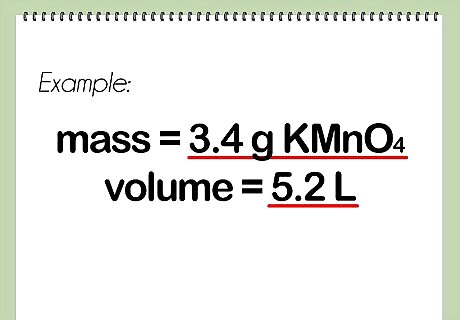
Examine the problem. Finding molarity demands that you have the number of moles and the number of liters. If you are not provided with the number of moles but you do have the volume and mass of the solution, you will need to use these two figures to calculate the number of moles before continuing on. Example problem: Mass = 3.4 g KMnO4 Volume = 5.2 L
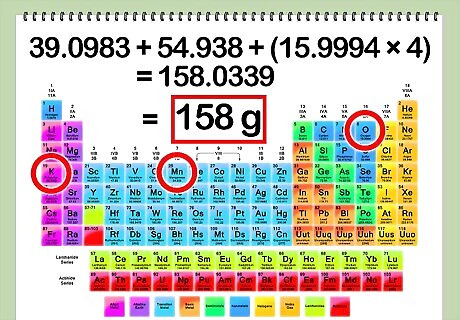
Find the molar mass of the solute. To calculate the number of moles from the mass or grams of solute used, you must first determine the molar mass of the solute. This can be done by adding together the separate molar masses of each element found in the solution. Find the molar mass of each element using the periodic table of elements. Make sure that you count the atoms for each element and calculate the molar mass of each of the atoms. Example problem: Molar mass of K = 39.1 g Molar mass of Mn = 54.9 g Molar mass of O = 16.0 g (The solute contains 4 O atoms, so count the 16g 4 times.) Total molar mass = K + Mn + O + O + O + O = 39.1 + 54.9 + 16 + 16 + 16 + 16 = 158.0 g
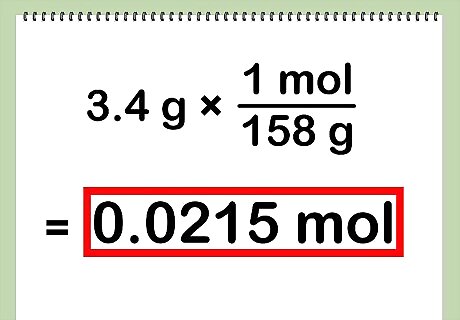
Convert the grams into moles. Now that you have the molar mass of the solute, you need to multiply the number of grams of solute in the solution by a conversion factor of 1 mole over the formula weight (molar mass) of the solute. This will give you the number of moles of the solute for this equation. Example problem: grams of solute * (1/molar mass of solute) = 3.4 g * (1 mol / 158 g) = 0.0215 mol The grams units of the solute and solute mass cancel each other out so you are left with mol units.

Divide the number of moles by the number of liters. Now that you have the number of moles, you can divide this value by the number of liters of solution in order to find the molarity. Example problem: molarity = moles of solute / liters of solution = 0.0215 mol / 5.2 L = 0.004134615

Write your answer. You should round off the number of digits after the decimal point to the place requested by your instructor. Usually, this will be two or three places after the decimal point. Additionally, when you write out the answer, abbreviate “molarity” with “M” and state the solute involved. Example problem: 0.004 M KMnO4
Calculating Molarity with Moles and Milliliters

Know the basic formula for calculating molarity. In order to find molarity, you need to calculate the number of moles of solute for a solution per liter of solution. Milliliters cannot be used. The general formula used to express molarity is written as: molarity = moles of solute / liters of solution. Example problem: What is the molarity of a solution containing 1.2 moles CaCl2 in 2905 milliliters?

Examine the problem. Calculating molarity requires you to have the number of moles and the number of liters. If you are provided with the volume in milliliters instead of liters, you will need to convert the volume into liters before continuing your calculations. Example problem: Moles = 1.2 mol CaCl2 Volume = 2905 ml

Convert the milliliters into liters. Find the number of liters by dividing the number of milliliters by 1000, since there are 1000 milliliters per 1 liter. Note that you could also simply move the decimal point to the left three places. Example problem: 2905 ml * (1 L / 1000 ml) = 2.905 L
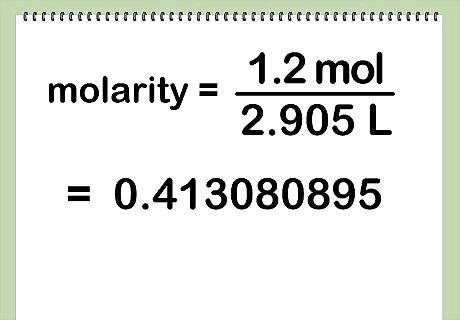
Divide the number of moles by the number of liters. Now that you have the number of liters, you can divide the number of moles of solute by this value in order to find the molarity of the solution. Example problem: molarity = moles of solute / liters of solution = 1.2 mol CaCl2 / 2.905 L = 0.413080895

Write your answer. Round off the number of digits after the decimal point to the amount requested by your instructor (usually two or three places). When you write out the answer, you should also abbreviate “molarity” with “M,” and state the solute. Example problem: 0.413 M CaCl2
Additional Practice Problem

Find the molarity of a solution made by dissolving 5.2 g of NaCl in 800 ml of water. Identify the values provided to you in the problem: mass in grams and volume in milliliters. Mass = 5.2 g NaCl Volume = 800 ml water

Find the molar mass of NaCl. Do this by adding together the molar mass of sodium, Na, and the molar mass of chlorine, Cl. The molar mass of Na = 22.99 g The molar mass of Cl = 35.45 g The molar mass of NaCl = 22.99 + 35.45 = 58.44 g

Multiply the mass of the solute by its molar mass conversion factor. In this instance, the molar mass of NaCl is 58.44 g, so the conversion factor is 1 mol / 58.44 g. Moles NaCl = 5.2 g NaCl * (1 mol / 58.44 g) = 0.08898 mol = 0.09 mol

Divide 800 ml of water by 1000. Since there are 1000 milliliters per liter, you will need to divide the number of milliliters in this problem by 1000 in order to find the number of liters. You could also look at it as multiplying 800 ml by a conversion factor of 1 L / 1000 ml. To hasten the process, you could simply move the decimal point three places to the left instead of multiplying or dividing anything. Volume = 800 ml * (1 L / 1000 ml) = 800 ml / 1000 ml = 0.8 L

Divide the number of moles of solute by the number of liters of solution. In order to find the molarity, you need to divide 0.09 mol, the number of moles of the solute NaCl, by 0.8 L, the volume of the solution in liters. molarity = moles of solute / liters of solution = 0.09 mol / 0.8 L = 0.1125 mol/L

Tidy up your answer. Round your answer off to two or three decimal places and abbreviate molarity with “M.” Answer: 0.11 M NaCl

















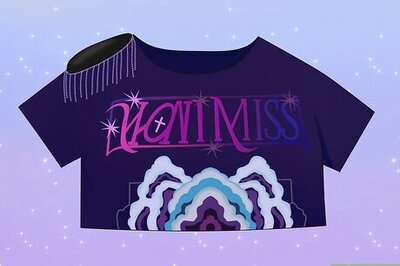
Comments
0 comment